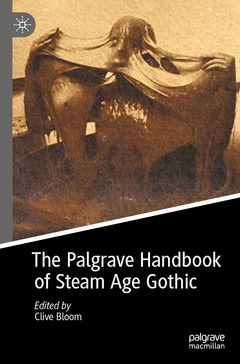The Palgrave Handbook of Steam Age Gothic, 1st ed. 2021
Coordonnateur : Bloom Clive

By the early 1830s the old school of Gothic literature was exhausted. Late Romanticism, emphasising as it did the uncertainties of personality and imagination, gave it a new lease of life. Gothic?the literature of disturbance and uncertainty?now produced works that reflected domestic fears, sexual crimes, drug filled hallucinations, the terrible secrets of middle class marriage, imperial horror at alien invasion, occult demonism and the insanity of psychopaths. It was from the 1830s onwards that the old gothic castle gave way to the country house drawing room, the dungeon was displaced by the sewers of the city and the villains of early novels became the familiar figures of Dr Jekyll and Mr Hyde, Dracula, Dorian Grey and Jack the Ripper. After the death of Prince Albert (1861), the Gothic became darker, more morbid, obsessed with demonic lovers, blood sucking ghouls, blood stained murderers and deranged doctors. Whilst the gothic architecture of the Houses of Parliament and the new Puginesque churches upheld a Victorian ideal of sobriety, Christianity and imperial destiny, Gothic literature filed these new spaces with a dread that spread like a plague to America, France, Germany and even Russia. From 1830 to 1914, the period covered by this volume, we saw the emergence of the greats of Gothic literature and the supernatural from Edgar Allan Poe to Emily Bronte, from Sheridan Le Fanu to Bram Stoker and Robert Louis Stevenson. Contributors also examine the fin-de-siècle dreamers of decadence such as Arthur Machen, M P Shiel and Vernon Lee and their obsession with the occult, folklore, spiritualism, revenants, ghostly apparitions and cosmic annihilation. This volume explores the period through the prism of architectural history, urban studies, feminism, 'hauntology' and much more. 'Horror', as Poe teaches us, 'is the soul of the plot'.
PART ONE: VICTORIAN TRANSFORMATIONS.- Gothic architecture for the steam age: Charles Barrie.- Augustus Pugin and family.- George Gilbert Scott and family.- the rebuilt Houses of Parliament, the restoration of medieval France.- Thomas Lovell Beddoes.- John Ruskin.- the gothic cemetery (Highgate etc) Victor Hugo.- the Brontes; Charles Dickens and the ghost story.- Edith Wharton.- Sheriden le Fanu.- Sabine Baring Gould.- domestic gothic.- melodrama and the gothic.- Egyptian gothic taste.- freaks and raree shows.- Egyptian gothic.- stage magic and the gothic.- real life ghosts and hauntings.- PART TWO: FIN DE SIECLE.- Guy de Maupassant.- gothic music- Wagner and Berlioz.- Robert Louise Stevenson, Dr Jekyll and Mr Hyde.- Ambrose Bierce.- magic lantern gothic.- Conan Doyle gothic.- Jack the Ripper.- the cult of Pan; Arthur Machen.- J K Huysman.- Bram Stoker and Dracula.- end of the century decadence-erotic gothic and occult gothic.- Oscar Wilde and the Picture of Dorian Gray.- Richard Marsh and the Beetle.- H G Wells.- the ghost tales of Edith Wharton.- Isaak Dineson.- Robert W Chambers: the King in Yellow.- Lord Dunsany.- Count Steinbock.- John Buchan.- end of the century ghost tales -minor writers.- bibliography.
Clive Bloom is Emeritus Professor at Middlesex University, UK. He has written numerous books on popular literature, gothic fiction, history and politics. He is a broadcaster and occasional journalist who has been quoted in both the Washington Post and Pravda and has an entry in the Columbia Book of World Quotations.
Provides a comprehensive overview, exploring every aspect of gothic culture from its origins in the seventeenth century right up to 2019
Offers cutting edge analysis of modern gothic through contemporary case studies such as the Slender Man meme
Creates a forum for new research— although traditional gothic areas will be revisited through contemporary theories and insights, long forgotten writers and neglected designers, architects, painters, poets and film makers will be highlighted
Date de parution : 02-2022
Ouvrage de 867 p.
15.5x23.5 cm
Date de parution : 02-2021
Ouvrage de 867 p.
15.5x23.5 cm
Thème de The Palgrave Handbook of Steam Age Gothic :
Mots-clés :
Gothic; Film; Literature; Television; Culture; Gothic fiction



